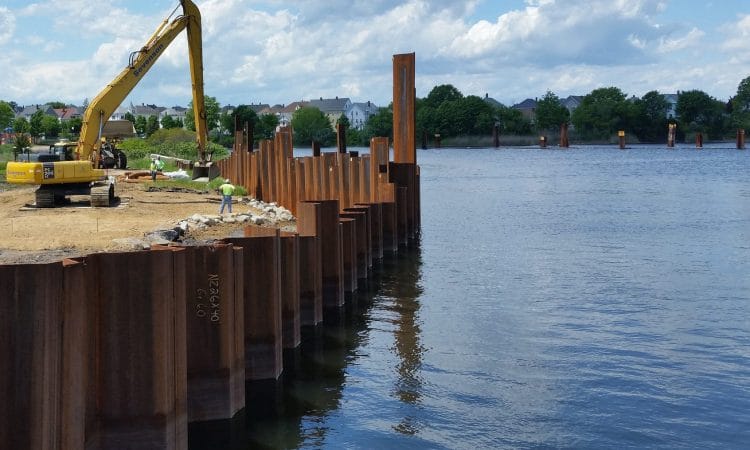
Bridgeville can fix its flooding problem without spending $30 million to radically reshape the Baldwin Street corridor, according to a team of Pitt engineering students who researched the issue for a senior project.
Borough officials could save money and significantly alleviate flood risk by raising creek banks and installing barriers to prevent cars, Dumpsters, and other large debris from clogging McLaughlin Creek during heavy rains, the undergrads explained last month.
During the past decade, floods in the Baldwin corridor have led to insurance claims totaling $2.5 million worth, and in June, an Upper St. Clair woman was killed by floodwaters.
“We believe there is a moral obligation to come up with a suitable design for the neighborhood,” said student Cecilia Burke.
Although the students stumbled a bit when comparing their flood solutions to an economic revitalization plan currently under council consideration, the engineering analysis was well received by Pitt faculty.
The team—comprised of Mason Krushinsky, Jessica Marquis, Jonny Nguyen, Jack James, and Cecilia Burke—researched Bridgeville’s floods and concluded that the problem lies not with the borough’s existing bridges and culverts, but rather, with the debris that clogs waterways during heavy rains.
Ideally, the borough would collaborate with Upper St. Clair and Bethel Park to find a solution for the entire watershed. But realistically, Bridgeville may have to act alone to reduce the damage caused by stormwater and debris from those upstream communities.
First, the students said, Bridgeville should install a series of hollow steel pipes in the creek near McLaughlin Park. These would serve as a “trash rack” to catch large debris before it reaches Bridgeville’s populated areas.

When debris accumulates at the trash rack, the excess water behind it would be temporarily diverted to a detention pond at McLaughlin Park
If this sounds familiar, that’s because Bridgeville is already applying for permits to install a trash rack and create a detention pond at the park. The timeline for actually making those improvements depends largely on getting approvals from various government agencies.
Further downstream, when McLaughlin Creek reaches Baldwin Street, one side of the creek bank is 15.5 feet high, according to the students, while the other is only 7.5 feet high.

A steel sheet wall like the one pictured above could bring the Baldwin Street side of the creek level with the McLaughlin Run Road side and greatly increase flow capacity.
As a second line of defense against flood-causing debris, the students recommended that the borough install another steel-pipe trash rack into the riverbed between Baldwin Street and McLaughlin Run Road.
All of this would cost Bridgeville at least $3 million. Probably a lot more, after paying for engineering, design, environmental studies, and other costs that come with civil engineering projects.
But even at $6 million, it’s a stark contrast to the $30 million Baldwin Street design that was sent to borough council in October.
That plan calls for Bridgeville to acquire more than 70 properties in the Baldwin Street corridor, re-route McLaughlin Run Road, and create a large greenspace along the creek banks.
In last week’s Signal-Item, John Oyler, the Pitt engineering professor and local historian who oversaw the students’ research, called the recommendation “obviously unacceptable to a group of competent engineers.”
However, Oyler, who could not be reached for comment, seems to misunderstand the full scope the Baldwin Street plan.
It is not—and was never intended to be—just a flood solution.
The end goal is to economically revitalize the Baldwin Street corridor. Flood control is a major part of that, but so are traffic patterns, parking areas, zoning changes, pedestrian trails, greenspace additions, and more.
Rather than displacing residents, all property acquisition would be voluntary. Council president Mike Tolmer has repeatedly emphasized that the borough would buy buildings as they became available on the market and would not use eminent domain.
But in defense of the students, after Baldwin Street went underwater in June, most people were concerned about flooding, not neighborhood revitalization.
And the one planning commission meeting that the students attended was mired in confusion, with many of the 12 residents in attendance unclear not just on the plan’s details, but on the metaphysical purpose of a borough planning commission.
The students’ research has already become a talking point at council meetings.
In December, former mayor Pat DeBlasio Jr. outlined the team’s presentation, linking it back to former councilman Bill Colussy, who advocated for debris clean-up and trash racks to reduce flood risk.
“What I left [the Pitt presentation] with was this,” DeBlasio said, “Billy Colussy was right.”